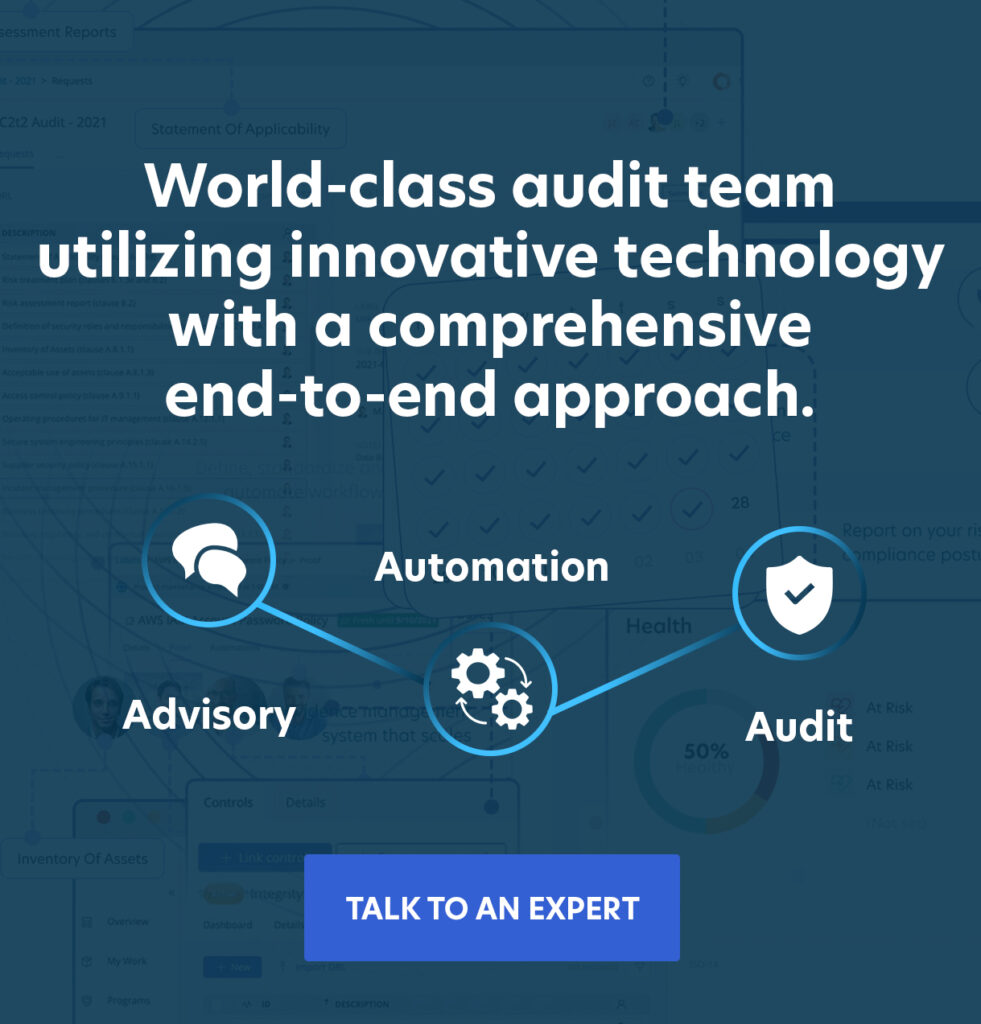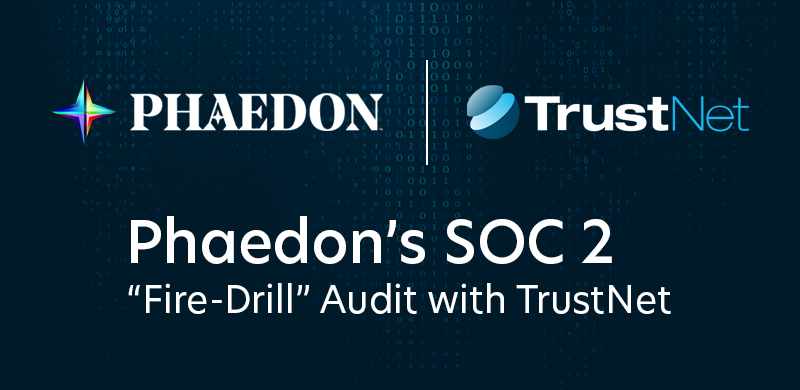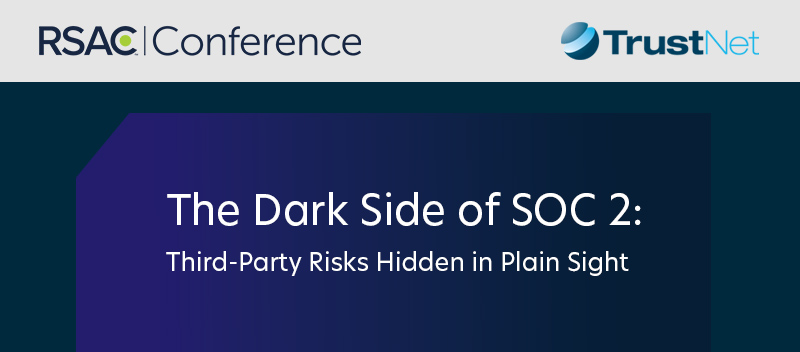How Business Leaders Ensure Third-Party Vendors Meet Security Requirements

Collaborating with third-party vendors is an essential aspect of modern business operations. These partnerships foster growth and innovation but come with their challenges. Security vulnerabilities in vendor relationships can jeopardize your organization’s reputation and shake client confidence.
To mitigate these threats, business leaders must enforce rigorous security measures and evaluate vendor compliance with precision. The stakes are high, and navigating these complexities demands strategic foresight and actionable solutions.
This article highlights:
-
- Strategies from 9 business leaders on strengthening vendor security oversight.
- TrustNet experts advise how vendors can meet and exceed critical security benchmarks using our key services.
Equip yourself with the knowledge to make vendor security a core strength for your business.
Insights from Industry Leaders: Expert Strategies for Ensuring Third-Party Vendor Security
— Prioritize Multi-Layered Vendor Security Evaluations
“In my role as an IT consultant, I prioritize vendor security evaluations by implementing a multi-layered vetting process. We use thorough assessments, reviewing not only their security certifications but also their operational history and reputation. A case in point is when working with a cloud service provider; I ensured they adhered to HIPAA and ISO 27001 standards to protect sensitive health data.
Additionally, I adopt continuous compliance monitoring, ensuring vendors maintain adherence post-selection. For instance, we use automated tools to audit vendors in real-time, flagging any deviations from PCI DSS compliance promptly. This proactive approach reduced compliance lapses by 40% in our partner network, maintaining trust and security.
Furthermore, we integrate contractual obligations with clear compliance clauses into vendor agreements. A specific example is our collaboration with a data center, where we required encryption and access control as part of our terms. Ensuring these are legally binding means there’s a structured path for accountability, aligning vendor actions with our comprehensive security framework.”
Ali Khan, Founder & CEO, MOATiT
— Select Vendors with Proven Certifications
“I am very selective when it comes to third-party vendors and service providers. To start, I only consider vendors who have proven experience and certifications in their respective fields. For example, I make sure they hold industry-specific certifications like SOC 2 or ISO 27001, which demonstrate a commitment to high standards of security. Once they clear that initial hurdle, I investigate their operational procedures, focusing on how they safeguard sensitive data. I’ve found that if they’re not transparent with their security practices upfront, that’s a red flag.
Beyond initial checks, I maintain a continuous monitoring process. This includes regular security audits and compliance reviews. For instance, when I worked with a new IT firm last year, we set up quarterly reviews to ensure their practices were up-to-date with new regulations. It was this hands-on approach that caught a potential compliance gap early on, saving us from future risk. Contracts are equally important to me, and I make sure each one is crystal clear on expectations. If there’s ever a breach or failure on their part, there’s no ambiguity about accountability. It’s a proactive approach, but one that’s necessary to protect both my clients and my practice.”
C.L. Mike Schmidt, Personal Injury Lawyer, Schmidt & Clark
— Detailed Vetting and Strong Relationships
“In my experience managing Fritch Law Office and interacting with third-party vendors, ensuring they meet our security and compliance needs involves detailed vetting processes. We frequently conduct due diligence to evaluate vendors’ adherence to legal and professional standards, similar to the comprehensive assessments I’ve performed in mergers and acquisitions. This involves verifying data protection measures and examining previous compliance track records, akin to ensuring regulatory compliance for our clients.
To safeguard against potential risks, I adopt a personalized approach by building strong relationships with vendors. This is in line with my commitment to client-focused service in my law practice. For instance, when working on estate planning, I ensure that financial advisors and other third parties have robust security measures, mirroring the meticulous care I take in selecting vendors.
Increasing transparency and consistent communication with vendors is crucial. From my time at Arthur Andersen in the tax department, where accuracy and compliance were paramount, I ensure ongoing dialogue about compliance updates and security protocols with third-party providers. This fosters a collaborative environment where my standards for legal and financial practices are upheld, offering peace of mind for both my firm and clients.”
David Fritch, Attorney, Fritch Law Office
— Risk-Based Approach to Vendor Assessments
“When it comes to ensuring third-party vendors meet our security and compliance requirements, I lean on a risk-based approach. At Next Level Technologies, we’ve implemented stringent vendor assessment strategies where we conduct regular audits and assessments on data management and security processes. For instance, with our healthcare clients, we ensure that vendors comply with HIPAA and HITECH standards by verifying encryption and access control measures.
We prioritize integrating secure APIs and services from third parties through a detailed evaluation process. An example is our selection process for anti-malware solutions, where we carefully review providers’ system compatibilities, update protocols, and past performance history before adoption. This allows us to create a robust cybersecurity environment for our clients.
Moreover, we adopt a shared responsibility model between us and our clients when working with third-party vendors. We lay down clear compliance boundaries and responsibilities, ensuring both our team and clients are aligned on roles. This method has helped streamline our process for managing and executing compliance collaboratively, while reducing risks associated with third-party interactions.”
Steve Payerle, President, Next Level Technologies
— Review Security Certifications and Practices
“When evaluating third-party vendors, I begin by reviewing their security certifications like ISO 27001 or SOC 2 to make sure they meet industry standards. I go beyond just checking boxes. I want to know how they handle sensitive data. Do they have strong encryption protocols? How quickly can they respond if there’s a breach? It’s not enough for them to have a great reputation. I need to see their real security practices and know their track record with audits. I’ve found that over 60% of breaches happen due to vendor weaknesses, so this step is non-negotiable for me.
Once we’re onboard, I make security a regular part of the conversation. We establish clear, enforceable terms in our contracts, outlining expectations on both sides. I schedule quarterly security reviews and spot audits to ensure compliance. For example, one vendor had an issue with outdated software, something they overlooked until we flagged it in an audit. It’s important to stay proactive. Regular updates to security protocols are a must, and I always communicate that we’re in this together to keep each other protected. Security isn’t just a checkbox; it’s an ongoing commitment.”
Chris Bajda, E-commerce Entrepreneur & Managing Partner, GroomsDay
— Require Security and Compliance Assessments
“Before signing any agreements, I require vendors to pass a security and compliance assessment. They must outline how they handle data, their encryption standards, and what measures they have in place to prevent breaches. A simple verbal confirmation isn’t enough. Everything must be documented, including adherence to GDPR, CCPA, or any relevant regulations. If they store client data, I need proof that it remains protected and accessible only to authorized personnel. Once a vendor is onboarded, the monitoring doesn’t stop. I schedule regular reviews to ensure their security policies remain up to date. Depending on the level of risk, I may request penetration test reports or audit logs. If a vendor fails to meet expectations, I don’t wait for issues to arise; I either enforce corrective measures or find a better alternative. Keeping client data secure is a responsibility and a necessity.”
Sean Clancy, Managing Director, SEO Gold Coast
— Ensure Compliance with Payment Integrations
“In my 25 years of experience delivering software applications with payment integrations, I’ve learned that ensuring third-party vendors meet security and compliance requirements is critical. At Agile Payments, we focus on solutions that cater to SaaS and their users, particularly in the US and Canadian markets. We employ stringent vetting processes when integrating vendors, emphasizing compliance with PCI standards in credit card processing, and utilizing tokenization for ACH transactions.
Our approach is to work closely with our payment gateway partners, facilitating solutions that take applications out of PCI scope. We’ve implemented secure pop-up lightboxes for sensitive data entry and tokenization to ensure data protection. For example, by transitioning to a single-stack API solution, we’re able to streamline integration time, improve security measures, and reduce the risk of exposure for our clients and their users.
Additionally, our risk mitigation tools help identify potential fraud early in the process. We partner with vendors who provide automated risk assessments and support merchant underwriting with thorough background checks. This multi-layered approach helps us maintain a high standard of compliance and security, ensuring that we, and our clients, remain protected against vulnerabilities.”
Gene Krause, VP Business Development, Agile Payments
— Clear Process for Evaluating and Managing Vendors
“Over the years, I’ve worked closely with external vendors, from tech providers to marketing partners, ensuring that they meet our strict security and compliance standards. The key to achieving this is having a clear process in place for evaluating, monitoring, and managing these relationships.
The first step is to conduct thorough due diligence before engaging any third-party vendors. This includes reviewing their security certifications, like ISO 27001 or SOC 2, and confirming they follow industry best practices for data protection. We ask for detailed reports on their security protocols, past compliance audits, and any measures they take to prevent data breaches. This helps us assess whether their standards align with ours.
Once a vendor is onboard, we have them sign detailed Service Level Agreements (SLAs) that include specific security and compliance expectations. These agreements outline how they should handle sensitive information, their responsibility for breach notifications, and their adherence to relevant regulations, such as GDPR.
We also conduct regular performance reviews, typically every six months, to ensure ongoing compliance. During these reviews, we assess whether their security practices remain effective and if they’ve kept up with any new regulatory changes. If any red flags arise, we immediately address them, and in some cases, may even terminate the relationship if their practices no longer meet our standards.
By being diligent in selecting and monitoring our third-party vendors, we ensure that our business remains secure and compliant with all necessary regulations.”
Jon Morgan, CEO, Business and Finance Expert, Venture Smarter
— Conduct Risk Assessment and Ongoing Monitoring
“Vetting third-party vendors is serious business. Contracts don’t mean much if security gaps expose data. The first step is a risk assessment–checking how they handle data, store it, and who has access. No proper encryption or access controls? No deal. A vendor’s compliance with SOC 2, GDPR, or HIPAA (if relevant) is non-negotiable.
Ongoing monitoring keeps things in check. Regular audits, penetration tests, and security questionnaires hold vendors accountable. If a vendor integrates with internal systems, least-privilege access applies–no unnecessary permissions. Security training for their team is a plus. A vendor isn’t just a tool; it’s part of the workflow. If they don’t take security seriously, they don’t belong.”
Natalia Lavrenenko, UGC manager/Marketing manager, Rathly
— Comprehensive Risk Assessment and Security Evaluations
“In today’s interconnected digital landscape, ensuring third-party vendors and service providers meet stringent security and compliance requirements is paramount. A robust due diligence process is essential to mitigate risks and safeguard sensitive information. This process begins with a comprehensive risk assessment, meticulously identifying potential vulnerabilities associated with each vendor’s services and their access to organizational data. This assessment dictates the scope and depth of subsequent security evaluations.
A critical step involves verifying the vendor’s security posture through detailed questionnaires and reviews of their security policies. These assessments should cover data encryption, access controls, incident response plans, and vulnerability management processes. Industry-recognized certifications, such as SOC 2, ISO 27001, and PCI DSS, are valuable indicators of a vendor’s commitment to security best practices. Requesting and reviewing these certifications provides an initial level of assurance.
However, relying solely on certifications isn’t sufficient. Organizations should conduct independent security audits or penetration testing directly or through trusted third-party firms to validate the vendor’s security claims and uncover hidden vulnerabilities.
Contracts play a vital role, explicitly outlining security responsibilities, compliance obligations, and data protection requirements. These agreements should include clauses addressing data breach notification procedures, incident response protocols, and audit rights. Defining these expectations upfront minimizes ambiguity and provides a legal framework for holding vendors accountable.
Ongoing monitoring is equally crucial. Continuous security monitoring programs, leveraging threat intelligence feeds and anomaly detection tools, can proactively identify potential security incidents involving the vendor’s systems or data.
Finally, it’s important to note that vendor security is an ongoing process, not a one-time event. By implementing these measures, organizations can establish a robust security posture that minimizes risks associated with third-party vendors and service providers.”
Steve Fleurant, CEO, Clair Services
Strengthen your vendor partnerships with robust security and compliance strategies.
Vigilance in Cybersecurity and Compliance
The business leaders highlighted the critical need for vigilance when managing third-party vendors.
Strengthen Security with Multi-Layered Evaluations
Business leaders stress the importance of conducting thorough, multi-layered evaluations to instantly uncover vulnerabilities and address security gaps. Organizations minimize risks and enhance operational readiness by taking a detailed, proactive approach to assessments.
- Ensure Trust Through Certifications
Leaders actively prioritize obtaining and maintaining industry certifications to verify compliance and build stakeholder trust. These certifications prove robust security measures, assuring clients and partners.
- Stay Ahead with Continuous Monitoring
Leaders continue to emphasize the critical measure of continuous monitoring. Real-time insights into system activities allow organizations to detect and respond to anomalies before they escalate, reducing downtime and financial impact.
- Clarify Expectations with Transparent Contracts
Clear, well-structured contracts are essential in fostering secure third-party relationships. Business leaders emphasize defining expectations, responsibilities, and security protocols from the start to prevent misunderstandings and ensure accountability.
TrustNet: Proactive Solutions for Third-Party Risk Management
At TrustNet, we provide the tools and expertise to transform vigilance into actionable results that drive business resilience and success.
- Identify and Eliminate Vulnerabilities
TrustNet uncovers security gaps before they can be exploited. Through targeted penetration testing, we empower businesses to strengthen defenses and confidently mitigate risks.
- Simplify Compliance Processes
TrustNet removes the complexity of regulatory compliance. Our PCI DSS and SOC assessments deliver precise, actionable insights to ensure your organization consistently meets industry standards with ease.
- Monitor Vendors with Precision
TrustNet keeps your third-party relationships secure with advanced vendor risk management solutions. We analyze vendor systems, flag potential threats, and provide detailed strategies to safeguard your operations.
- Achieve Continuous Oversight
Stay ahead of threats with TrustNet’s continuous monitoring services. We provide real-time visibility into vendor performance, ensuring your organization is always prepared to address emerging risks.
With TrustNet as your partner, you can control vendor security, protect critical assets, and build lasting trust across your operations.
Bridging Expertise and Innovation with TrustNet’s Accelerator+
True cybersecurity relies on the perfect balance between human intelligence and advanced tools. While technology drives efficiency, the human touch brings depth, foresight, and adaptability, allowing organizations to address challenges that algorithms alone cannot solve. Combining expert judgment with cutting-edge preventive methods is crucial for effective defense and sustained compliance.
TrustNet’s Accelerator+ embodies this harmony with a three-pronged approach to strengthen your security posture and streamline compliance:
-
-
- Advisory: Our experts perform detailed evaluations of your operations, revealing vulnerabilities and guiding you toward compliance excellence. This analysis strengthens your resilience against potential threats.
- Automation: With platforms like GhostWatch and iTrust, we amplify your compliance and security processes.
- GhostWatch ensures 24/7 monitoring, automates compliance workflows, and provides real-time threat intelligence.
- iTrust uses machine learning to predict risks, manage third-party vulnerabilities, and safeguard against potential breaches.
- Audit/Assessment: Our auditors/assessors deliver focused audits, offering actionable insights while aligning your business with key frameworks like SOC, PCI DSS, ISO 27001, etc.
-
Disclaimer: Throughout this article, insights from CISOs, CEOs, and other executives are provided for illustrative purposes. These individuals may or may not be connected to TrustNet.
TrustNet’s Accelerator+ approach streamlines compliance and proactively manages vendor risks. Contact our experts today to get started.
Subscribe to the TrustNet Newsletter
actionable cybersecurity strategies, and TrustNet’s cutting-edge solutions.




